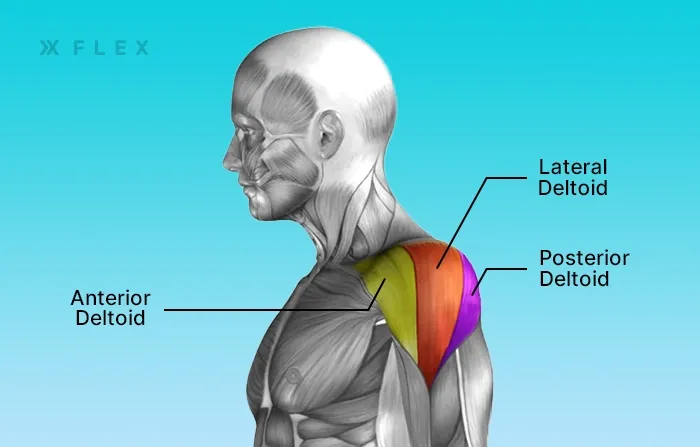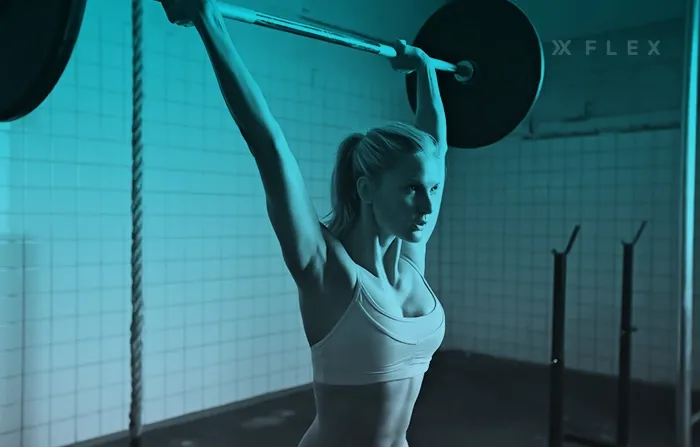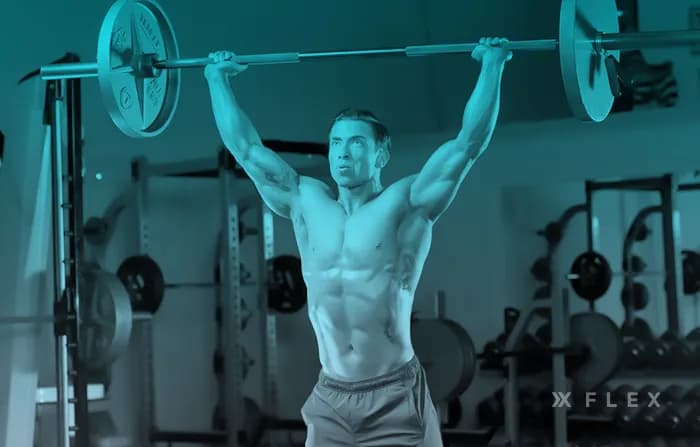Military Press vs. Shoulder Press
Best exercises to build big shoulders and get better shoulder health. Find out how the military press can give you defined shoulders.
Figure out the best shoulder-building move for a more balanced physique.
Having balanced shoulders and a strong upper body is one of the most aesthetically pleasing ways to improve your physique.
A toned and tapered look, on both women and men, can give you the illusion of a more balanced frame which can make you look and feel heavenly. (Read: greek god workout)
Working out your shoulders is also key to great shoulder health and mobility. These will keep you strong and healthy even well into older age.
The shoulder press is one of the best upper-body building functional moves you can do. Along with flys and lateral raises, shoulder pressing will let you hit all the major muscles of the shoulder. These two moves are similar with a few key differences.
This article will introduce you to both the military press and the shoulder press. Plus, see how you can work these shoulder-strengthening moves into your upper-body routine.
If you’re looking for developed delts, keep on reading to learn about the mechanics of both press styles.
Although these moves are slightly different, they do both target the shoulder muscles and can certainly give you a powerful upper-body workout.

What Muscles do Shoulder Presses Work?
The shoulder press and the military press both work the muscles of your shoulders, chest, and upper back. These include:
Pectoralis Major
The Pectoralis Major muscle (aka the pecs) is the biggest muscle at the front of your chest. Although it looks like two muscles, technically it’s considered one paired muscle.
This Pectoralis Major flexes, adducts (moves towards your body), and rotates the humerus bone of your arm. This muscle also helps keep your shoulders stable.
Anterior Deltoid
The anterior deltoids, aka “front delts” helps you move your arms forward and connects to your clavices.
Trapezius
Your traps help keep your shoulder blades (scapulae) stable. The trapezius are largely, trapezoid-shaped muscles that extend along your shoulders, neck, and down your back.
Both movements will work through the muscles of your shoulders, but the overhead press requires less pure power from the shoulders.
We’ll explore a bit more about how the different foot stances you assume in each of these presses give you a different driving force behind your movement. That being said, both are great ways to target and build shoulder strength.
What is a Military Press?
The military press is a technique that focuses on the anterior and posterior (front and back) deltoids to push weight above your head.
In true military fashion, a military pres is done with your feet together, so you are standing “at attention.”

What is a Shoulder Press?
A shoulder press, also known as an overhead press, requires a similar type of muscle activation as a military press.
This technique gives you a lot of power to propel your barbell overhead. Because you’re using leg, core, and low body strength to drive your barbell overhead, you may find this variation feels more stable than a military press base.
What are the Differences Between a Shoulder Press and a Military Press?
The key difference is that a shoulder press or overhead press starts with a wider base stance. Since your feet are hip-width apart or slightly wider, the shoulder press gives you the option to drive out of your feet.
The narrow foot width of a military press relegates nearly all of your work to the shoulders and the top of your core to drive movement. This limits your potential for lifting heavier weights and makes this more of a shoulder isolation move.
Do Military Press and Shoulder Press Work the Same Muscles?
When it comes to shoulder work, yes, these moves work the same muscles.
Both the military press and the shoulder press are focused on the anterior and posterior deltoids (the front and back of the shoulders).
Military presses, however, use more upper body strength and core engagement to push your barbell upwards.
A shoulder press allows some of the effort to drop into your lower body, letting your legs assist your lift and drive to get your barbell overhead.
For other workouts that target similar muscles, you can read:
Is a Military Press More Effective than a Shoulder Press?
Both of these moves are highly effective at helping you build defined shoulders and strong delts.
The military press, though, is a bit riskier than a traditional shoulder press. Because of your narrower base (a close-legged stance) and lack of leverage from the legs, you are dumping more effort into your shoulders during a military press.
The military press may limit the amount of weight you can lift safely. You’re also more likely to plateau quickly in this variation since you can’t load the legs at all.
Because of these factors, the military press is less effective than a regular shoulder press for most people.
Remember that every weightlifter’s body is unique. A method that works for someone else may not be as useful for you.
Give both styles a try and see which feels better for your body. You may also wish to incorporate both styles of presses on different shoulder or upper body days. Because the muscles worked are so similar though, skip the military press if you plan to shoulder press on a given day and vice versa.
Overhead Press— Tips and Tricks
How to Perform a Military Press
These quick steps will take you through the proper technique to perform a military press.
- On a squat cage or rack, load a medium to heavy weight onto your racked barbell.
- Approach the barbell and unrack it, resting it across your collarbones and the tops of your shoulders.
- Keep a solid grip on the barbell. Your palms should be facing away from you (overhand grip) and your elbows should be bent to support the barbell.
- Bring your feet close and stand with them directly together. (Hint: think about standing “at attention,” like a soldier would).
- Without driving through your legs, drive the barbell upward, using your shoulder and upper body strength to bring it to an overhead position. Straighten your arms, but do not lock the elbows out.
- Hold for a short pause, then slowly, and with control, lower your barbell back to the collarbones.
- Repeat as needed.
How to Perform a Shoulder Press
- From a squat rack, load a comfortable weight onto your barbell.
- Approach the barbell and unrack it, resting it across your collarbones and the tops of your shoulders.
- Keep a solid grip on the barbell. Your palms should be facing away from you (overhand grip) and your elbows should be bent to support the barbell.
- Separate your feet so that they are hip-width apart. You may wish to bring your feet slightly wider than this or point your toes out at a 15-45-degree angle if it feels more comfortable.
- Engaging your core, drive the barbell upward, using your shoulder and upper body strength to bring it to an overhead position. Straighten your arms, but do not lock the elbows out.
- Hold for a short pause, then slowly, and with control, lower your barbell back to the collarbones.
- Repeat as needed.
Is the Overhead Press Safer than the Military Press?
Both of these moves can be performed safely with proper technique, but the military press may put a bit more stress on the muscles of your rotator cuff.
This delicate group of shoulder muscles is a very common site for mechanical injuries. For functional movement, a rotator cuff injury or tear can be significantly debilitating when lifting things or even propping your weight up using your arms.
The wider base and more even weight distribution in a shoulder press vs. a military press can make the former a healthier move for most people.
With great form, though, there’s no reason a military press can not be performed safely.
Big Picture
Shoulder presses and military presses are both great upper-body moves to strengthen your shoulders. Both of these moves can be safely worked into a weightlifting program and both promote functional strength and shoulder muscle hypertrophy.
They do, however, come with a few critical differences.
The main difference is foot stance width. A shoulder press (aka overhead press) starts with the feet hip-width apart. A military press has the lifter keeping the feet together so they touch to form a narrow base for the movement.
The narrow foot width of a military press relegates nearly all of your work to the shoulders and the top of your core to drive movement. This limits your potential for lifting heavier weights and makes this more of a shoulder isolation move.
Whichever press you try, both of these moves are great ways to work your shoulder muscles and develop a bigger upper body.
You can incorporate them alongside moves like lateral raises and dumbbell flys to get built shoulders that are strong with a great range of motion.
Not keen on shoulder pressing? For a different type of upper body workout, learn more about targeting your chest muscles.
Or if you want a lower body burn, why not focus on glute-activating workouts? Learn more about different butt shapes, whether you’re looking for a heart-shaped, rounded, or overall balanced booty.
Take your fitness game to the top. Flex AI offers an all-in-one workout platform to help you learn new exercises, visualize your fitness journey, and keep all your PRs in one place.
We’ve made it simple to work on customized fitness plans or to introduce a little friendly competition to your fitness community by sharing exercises with your friends. Try it for free through the Flex fitness app.
References
Campos, Y. A. C., Vianna, J. M., Guimarães, M. P., Oliveira, J. L. D., Hernández-Mosqueira, C., da Silva, S. F., & Marchetti, P. H. (2020). Different Shoulder Exercises Affect the Activation of Deltoid Portions in Resistance-Trained Individuals. Journal of human kinetics, 75, 5–14. https://doi.org/10.2478/hukin-2020-0033
Elzanie A, Varacallo M. Anatomy, Shoulder and Upper Limb, Deltoid Muscle. [Updated 2023 May 8]. In: StatPearls [Internet]. Treasure Island (FL): StatPearls Publishing; 2023 Jan-. Available from: https://www.ncbi.nlm.nih.gov/books/NBK537056/
Luczak, J., Bosak, A., & Riemann, B. L. (2013). Shoulder Muscle Activation of Novice and Resistance Trained Women during Variations of Dumbbell Press Exercises. Journal of sports medicine (Hindawi Publishing Corporation), 2013, 612650. https://doi.org/10.1155/2013/612650
Maruvada S, Madrazo-Ibarra A, Varacallo M. Anatomy, Rotator Cuff. [Updated 2023 Mar 27]. In: StatPearls [Internet]. Treasure Island (FL): StatPearls Publishing; 2023 Jan-. Available from: https://www.ncbi.nlm.nih.gov/books/NBK441844/
Ourieff J, Scheckel B, Agarwal A. Anatomy, Back, Trapezius. [Updated 2023 Mar 11]. In: StatPearls [Internet]. Treasure Island (FL): StatPearls Publishing; 2023 Jan-. Available from: https://www.ncbi.nlm.nih.gov/books/NBK518994/
Solari F, Burns B. Anatomy, Thorax, Pectoralis Major Major. [Updated 2023 Jul 24]. In: StatPearls [Internet]. Treasure Island (FL): StatPearls Publishing; 2023 Jan-. Available from: https://www.ncbi.nlm.nih.gov/books/NBK525991/
Related articles


Get fit with Flex
Build muscle & lose weight fast for free.
Available on iPhone + Apple Watch





